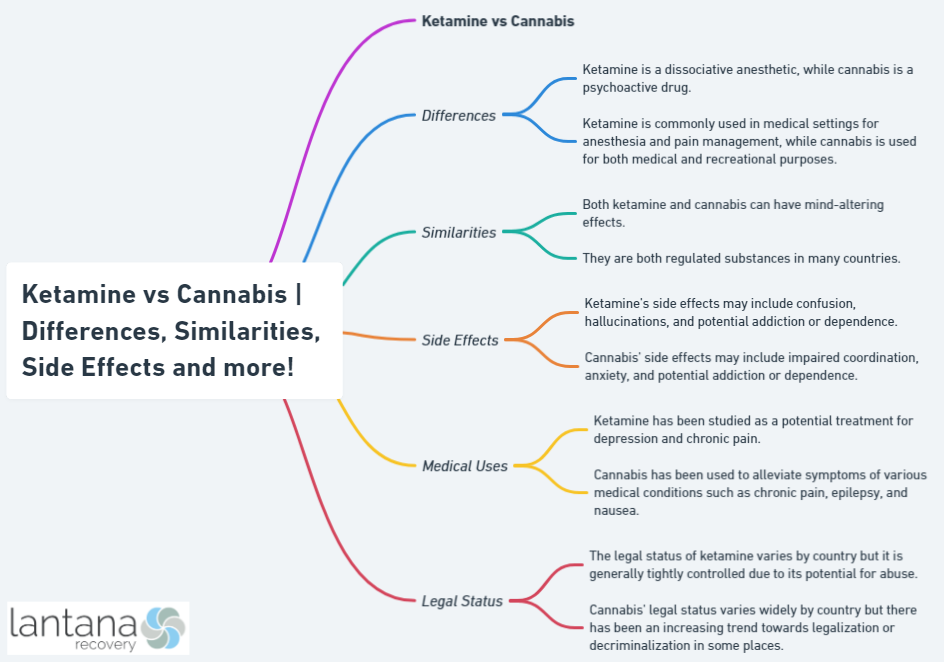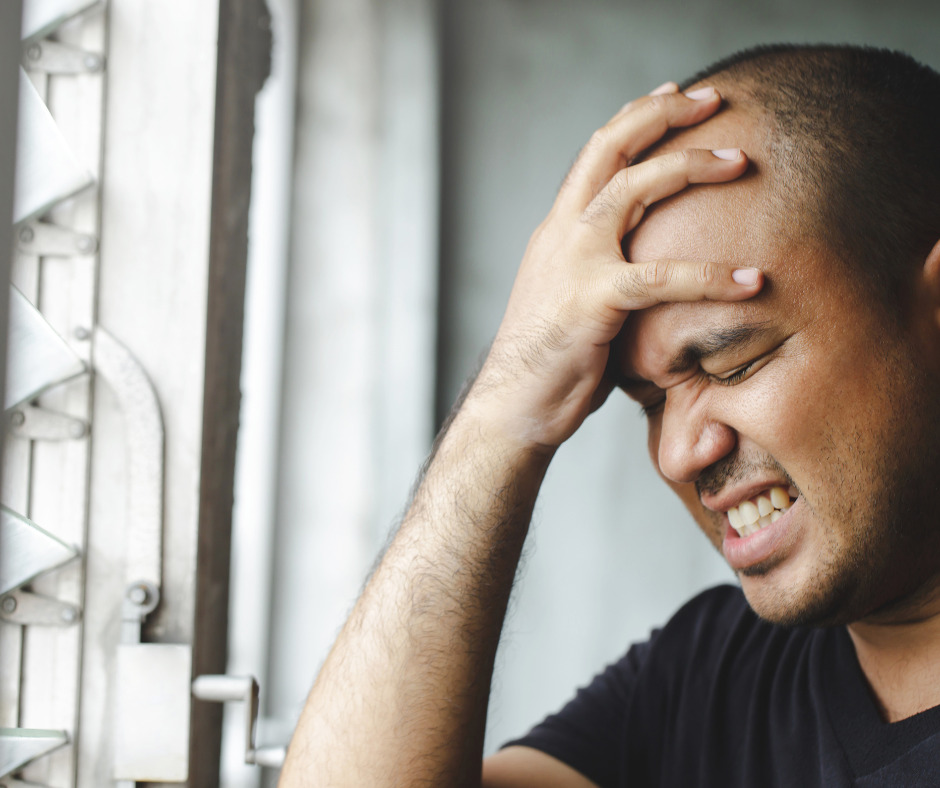Ketamine and cannabis are two drugs that have been used for various purposes, including recreational use, medical treatment, and therapy. While they may have some similarities, such as their ability to alter mood and perception, they also have distinct differences in their effects on the body and mind.
This article will explore the differences and similarities between ketamine and cannabis, including their uses, side effects, and potential for addiction. Whether you’re curious about these substances for recreational use or seeking information for medical purposes, this article aims to provide a comprehensive overview of these two drugs.
What is Ketamine?
Ketamine is a medication primarily used for anesthesia and pain relief. It is classified as a dissociative anesthetic and can induce a trance-like state while providing pain relief, sedation, and amnesia. Ketamine is also used off-label for treating depression, anxiety, and post-traumatic stress disorder (PTSD) in some cases.
Ketamine works by blocking the action of a neurotransmitter called glutamate, which is involved in the transmission of pain signals and also plays a role in learning and memory. This mechanism of action is different from other anesthetics, which typically work by blocking the action of another neurotransmitter called gamma-aminobutyric acid (GABA).
Ketamine is considered a Schedule III controlled substance in the United States due to its potential for abuse and dependence.
Chemical Composition of Ketamine
The chemical composition of ketamine is C13H16ClNO, which means that it contains carbon, hydrogen, chlorine, nitrogen, and oxygen atoms. It is a racemic mixture, which means that it contains two mirror-image molecules that are not superimposable.
What is Cannabis?
Cannabis is a plant that is commonly used for its psychoactive properties. It is also known as marijuana, weed, or pot, among other names. Cannabis has a long history of use in various cultures for medicinal, recreational, and spiritual purposes.
In many parts of the world, the plant has been used for thousands of years for its therapeutic properties, including pain relief, anxiety reduction, and sleep aid. However, cannabis use is also associated with potential side effects, such as impaired memory, concentration, and coordination.

Chemical Composition of Cannabis
The chemical composition of cannabis can vary widely depending on factors such as the strain of the plant, growing conditions, and method of extraction. However, the two most abundant and well-known cannabinoids found in cannabis are tetrahydrocannabinol (THC C21H30O2) and cannabidiol (CBD C21H30O2).
Ketamine vs. Cannabis: Fact Sheet
| Ketamine | Cannabis | |
| Generic Name | Special K | Hash |
| Drug Type | Anesthetic | Psychoactive |
| Active Ingredients | C13H16ClNO | THC (C21H30O2) and CBD (C21H30O2) |
| Used as treatment for: | Pain during surgery | Side effects of chemotherapy and AIDA |
| Available Form(s) | Injection, Pills, Inhalants | Dried Flowers Extract |
| Is it a controlled substance? | Yes | Yes, Schedule I |
| Legal Status | Class C drug | Illegal |
| Risk of Withdrawal Effects | Yes | Yes |
| Risk of Addiction | Yes | Low But Yes |
If you or someone you know is suffering from ketamine or cannabis addiction, please speak with our addiction recovery specialist today.
Cannabis Dosage and Side Effects:
The dosage of cannabis can vary depending on the strain, method of consumption, and individual tolerance. It is recommended to start with a low dosage and gradually increase as needed to avoid potential side effects.
For smoking or vaping, a typical starting dosage is one to two inhalations, and for edibles, a starting dosage is typically 5-10 milligrams of THC. However, it is important to note that the effects of edibles can take longer to kick in, so it is advised to wait at least 2 hours before increasing the dosage.
Cannabis use can also have various side effects, which can vary depending on the individual and dosage. Common side effects include dry mouth, red eyes, increased appetite, and drowsiness. In some cases, cannabis use can also lead to anxiety, paranoia, and panic attacks, especially in higher doses or in individuals who are sensitive to THC.
Long-term cannabis use has also been associated with potential negative effects on memory, attention, and learning, particularly in adolescent users. Therefore, it is important to use cannabis responsibly and in moderation to avoid potential adverse effects. It is also recommended to consult with a healthcare professional before using cannabis, especially if you have a pre-existing medical condition or are taking any medication.
Ketamine Dosage and Side Effects:

Ketamine dosage can vary depending on the purpose of use, age, weight, and medical condition of the patient. As a general rule, the dosage of ketamine should always be determined and administered by a trained medical professional.
For anesthesia purposes, ketamine is typically administered through injection and dosages can range from 0.5 to 2 milligrams per kilogram of body weight. For the treatment of depression, lower doses of ketamine are used, typically administered intravenously or intranasally.
Ketamine use can also have various side effects, which can vary depending on the dosage and individual. Common side effects of ketamine include dizziness, confusion, blurred vision, nausea, and vomiting. Higher doses of ketamine can cause more serious side effects, such as hallucinations, delirium, and loss of consciousness.
Ketamine can also cause respiratory depression and should be used with caution in patients with respiratory conditions, such as asthma or chronic obstructive pulmonary disease (COPD). Long-term use of ketamine has been associated with potential bladder and kidney problems, as well as cognitive and memory impairment.
It is important to note that ketamine has the potential for abuse and addiction. Therefore, it should only be used under the supervision of a trained medical professional in a controlled setting.
Additionally, individuals with a history of substance abuse or addiction should use ketamine with caution, if at all. It is recommended to consult with a healthcare professional before using ketamine, especially if you have a pre-existing medical condition or are taking any medication.
Cannabis vs. Ketamine: Can You Withdrawal for Either?

Both cannabis and ketamine can lead to withdrawal symptoms when someone stops using them after developing a dependence.
Withdrawal from cannabis, also known as marijuana or weed, may include symptoms such as irritability, anxiety, insomnia, loss of appetite, and physical discomfort. These symptoms typically begin within one to two days after the last use and can last for up to two weeks or longer.
Withdrawal from ketamine, on the other hand, can be more severe and may include symptoms such as anxiety, depression, insomnia, fatigue, and cognitive problems. These symptoms can occur within 24 hours of the last use and can last for several days to several weeks.
It’s important to note that while withdrawal from cannabis may be uncomfortable, it is not typically life-threatening. However, withdrawal from ketamine can be dangerous, and in some cases, it may require medical supervision to manage symptoms and prevent complications.
If you or someone you know is experiencing withdrawal symptoms from cannabis or ketamine, it’s important to seek help from a medical professional or addiction specialist who can provide guidance and support throughout the withdrawal process.
Ketamine vs Cannabis: Prevalence in the United States
According to the 2019 National Survey on Drug Use and Health (NSDUH), approximately 48.2 million people aged 12 or older used cannabis in the past month, representing 18% of the U.S. population. In contrast, the NSDUH estimated that 0.33 million people aged 12 or older used ketamine for non-medical purposes in the past year, representing 0.13% of the U.S. population.
The same survey also found that cannabis was the most commonly used illicit drug in the past month, followed by cocaine and hallucinogens. Ketamine was not listed as one of the top 10 most commonly used illicit drugs in the past month.
Additionally, a study published in the journal JAMA Psychiatry found that the prevalence of cannabis use disorder among adults in the U.S. increased from 1.5% in 2002 to 2.9% in 2016. In contrast, there is limited data on the prevalence of ketamine use disorder in the U.S.
Overall, these statistics suggest that cannabis is more prevalent and widely used than ketamine in the United States. However, it is important to note that both drugs can have potential risks and adverse effects when used improperly or abused.
Bottom Line: Ketamine versus Cannabis

In conclusion, both ketamine and cannabis are drugs that have unique effects on the mind and body. While they may have some similarities, such as their ability to alter mood and perception, they also have distinct differences in their uses, side effects, and potential for addiction.
It’s important to understand the potential risks and benefits of these drugs before using them and to seek help if you or someone you know is experiencing addiction or withdrawal symptoms. Ultimately, whether you choose to use cannabis or ketamine, it’s crucial to approach these substances with caution and to prioritize your physical and mental health.
FAQs on Cannabis and Ketamine
Ketamine vs Cannabis: Which is more addictive?
Both ketamine and cannabis have the potential to be addictive, but the addictive potential can vary depending on various factors such as frequency and dosage of use, individual susceptibility, and method of use. However, ketamine is usually considered more addictive than cannabis.
Is it safe to mix cannabis with crack?
No, it is not safe to mix cannabis with crack. Combining these two substances can lead to unpredictable effects, such as increased heart rate, anxiety, paranoia, and even overdose. It is highly recommended to avoid mixing drugs and to seek professional help if you struggle with substance abuse.
What are the signs of ketamine addiction?
The signs of ketamine addiction can vary but can include physical, psychological, and behavioral symptoms. Physical symptoms of ketamine addiction may include increased tolerance, dependence, and withdrawal symptoms such as nausea, sweating, and muscle cramps. Psychological symptoms can include cravings, anxiety, and depression.





